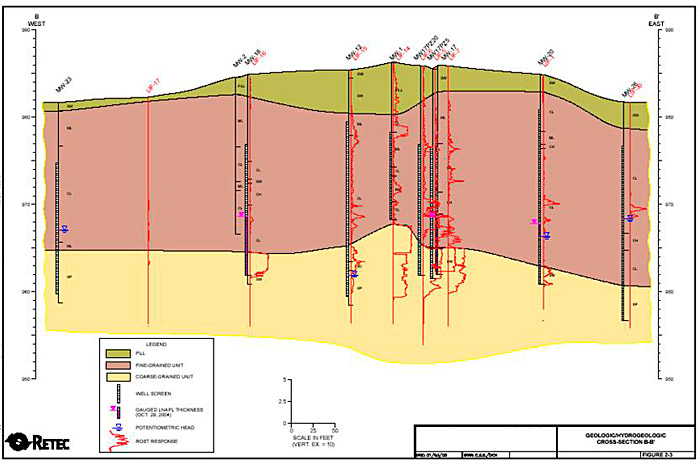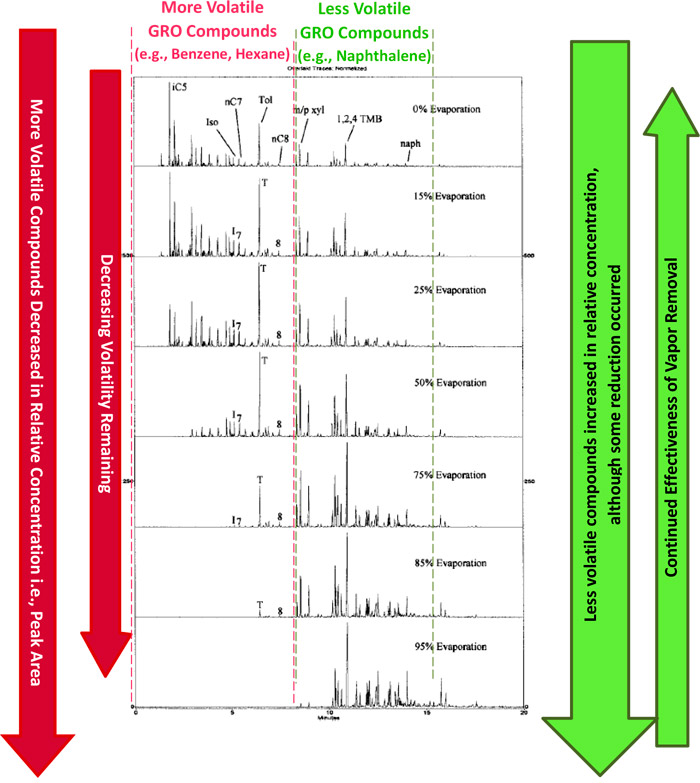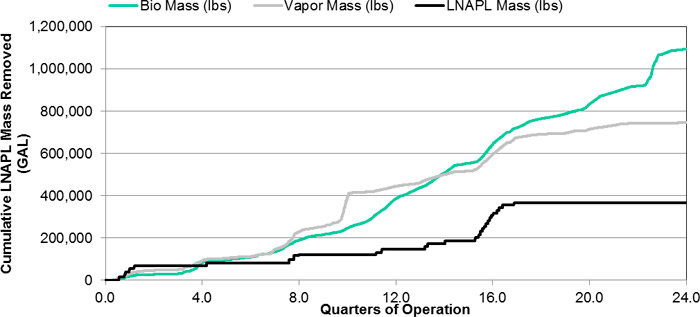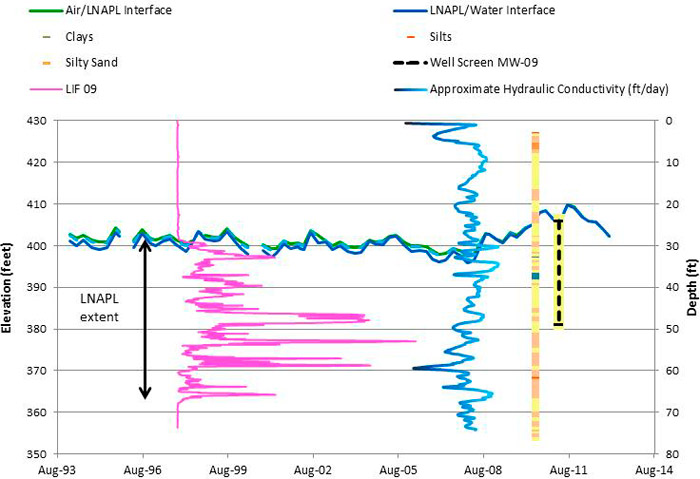4. LNAPL Conceptual Site Model (LCSM)
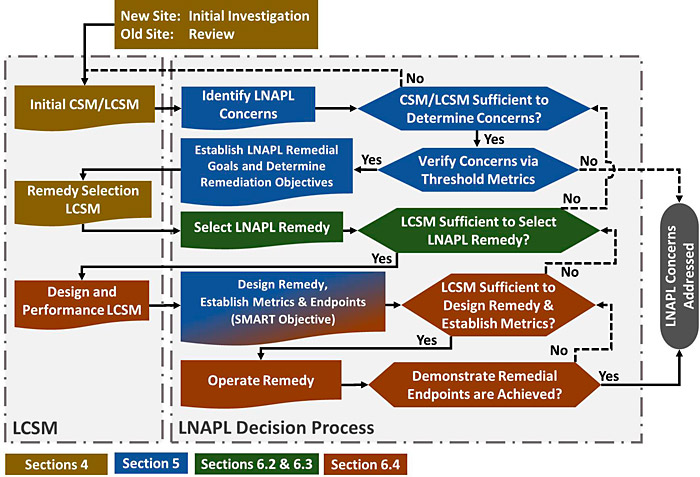 Figure 4-1. LNAPL conceptual site model (LCSM) stages and integration with LNAPL alternative evaluation.
Figure 4-1. LNAPL conceptual site model (LCSM) stages and integration with LNAPL alternative evaluation.
The LCSM is the collection of information that incorporates key attributes of the LNAPL body with site setting and hydrogeology to support site assessment and corrective action decision-making. As with a conceptual site model for a non-LNAPL contaminated site, the LCSM integrates information and considerations specific to the LNAPL body relating to the risks of the contaminant source, exposure pathways, and receptors (for examples, see (ASTM 2014a). The content of the LCSM will typically evolve over time as different phases of the corrective action process require different information. What remains consistent is the emphasis in the LCSM on characterizing and understanding the source component, the LNAPL (see (ASTM 2014b)).
From the moment of release and as a site matures, ongoing NSZD processes can affect significant changes to the LNAPL body such as stability, mobility, and recoverability and associated dissolved- and vapor-phase plumes. Ongoing remediation can also contribute to continuing changes or be ineffective. A complete and up-to-date LCSM allows the best possible management decisions about application and operation of remedial technologies (see (ASTM 2014b)). Further, remedial action data provides important feedback on the LCSM; for example, effective attainment of objectives provides validation, while non-attainment of objectives is often rooted in an incomplete LCSM and misdirected use of a given technology. The LCSM may comprise some or all of the following scientific and technological information (hereinafter referred to as the “science”):
- site setting (historical and current)—includes land use (as it informs potential sources), groundwater classification, presence and proximity of receptors, etc.
- geological and hydrogeological information/setting
- LNAPL physical properties (density, viscosity, interfacial tension, vapor pressure) and chemical properties (constituent solubilities and mole fractions)
- LNAPL body spatial distribution (vertical and horizontal delineation)
- LNAPL mobility and body stability information
- LNAPL recoverability information
- associated dissolved-phase and vapor-phase plume information (as it informs LNAPL distribution and pathways to receptor)
- LNAPL natural depletion processes (including rate measurements or estimates, if available)
These elements were introduced in ITRC’s initial LNAPL guidance (LNAPL-1 and -2 documents), and for this update they have been grouped by the decisions that they support and transformed into the key questions in Section 4.2 and Section 4.4 that will help the investigator characterize, monitor, and understand LNAPL sources at their site. In answering the questions, the investigator will seek out the appropriate lines of evidence that bring the LNAPL concerns into sharper focus. This section is focused on what information is needed at what point for a given site. Section 3 provides insight to detailed LNAPL science. In addition, Section 4.3 includes a table summarizing LCSM data collection parameters, applicable tools, and educational references for investigation that may be useful in answering the key questions.
LNAPL source zones require utilizing lines of evidence which encompass microbiology, hydrogeology, petroleum chemistry, geochemistry, vapor transport. The reader must recognize the multifaceted aspects and utilize additional references provided throughout this document for detailed understanding of the LNAPL science.
The evolution of the LCSM during the corrective action is driven by the answers to questions shown in Figure 4-1 and by the three stages identified below:
- The Initial LCSM identifies concerns by defining the nature and extent of LNAPL and how it relates to receptors and pathways. (see Section 4.2)
- The Remedy Selection LCSM provides for remedy evaluation and selection of the most efficacious remedial technology or controls by characterizing aspects of the LNAPL and site subsurface relative to the potentially employed remedial mechanisms. (see Section 4.4)
- The Design and Performance LCSM provides remedy implementation support and guides termination, remedy transition, or optimization through monitoring remedy performance metrics relative to the remediation objective. (see Section 6.4.1)
Over the life cycle of a typical LNAPL site investigation and remediation, the LCSM may include, but does not necessarily require, the three stages of evolution, each with a specific focus and a specific set of outcomes.
At the first stage, the focus of the Initial LCSM is the identification of one or more LNAPL concerns. An LNAPL concern is an LNAPL condition or potential condition that could:
- pose a risk to health or safety;
- result in additional LNAPL migration;
- address an LNAPL-specific regulatory requirement; or
- create some other physical or aesthetic impact or other specific regulatory or stakeholder requirement.
A well-developed Initial LCSM summarizes LNAPL and site conditions sufficiently to guide the identification and refinement of LNAPL concerns. Some LNAPL concerns may be readily identified in the early stages of site characterization, and others may be identified or further refined. It is recommended that the Initial LSCM includes sufficient information to verify LNAPL concerns using threshold metrics where available, and to establish Remedial/Control Goals. Section 5 provides further information on verifying initial LNAPL concerns, and translating verified LNAPL concerns into an LNAPL remedial strategy. This process is illustrated in Figure 4-1 in the blue steps and the initial green step.
At the second stage, the focus of the LCSM shifts to selecting potential remedial options. The outcome of the Remedy Selection LCSM is the identification of one or more LNAPL remedies or controls that address the verified LNAPL concerns. The Remedy Selection LSCM should include sufficient information to select appropriate remedies or control measures that are capable of abating the verified LNAPL concerns. These steps are illustrated by the green steps in Figure 4-1. Section 5 and Section 6 provide further information on selecting an LNAPL remedy/control strategy.
As illustrated by the red steps in Figure 4-1, in the third stage, the focus of the LCSM shifts to designing and implementing the selected remedial measures or controls, establishing technology-specific remediation objectives, and assessing progress and performance toward identified technology-specific remediation endpoints. The outcome of the Design and Performance LCSM is the implementation of one or more LNAPL remedies or controls that can achieve the established remediation objectives. The Design and Performance LCSM should include sufficient information to establish remediation objectives, design and implement remedies or control measures, and track progress toward defined remediation endpoints. Section 5 and Section 6 provide further information on establishing remediation objectives, implementing remedies, and identifying and tracking progress toward remediation endpoints.
The level of detail required in an LCSM for a specific site is a function of the complexity of environmental conditions, potential risk considerations, the regulatory framework, and overall LNAPL site management and remediation objectives (ASTM 2014b).
4.1 How Much Data is Enough?
ASTM International (ASTM 2014b) advocates development of an LCSM to evaluate LNAPL sites in a manner consistent with the Risk-Based Corrective Action (RBCA) process (see ASTM E1739–95 (ASTM 2015)) for more information about the RBCA process). ASTM identifies three tiers of LCSMs based on site complexity: Tier 1, Tier 2, and Tier 3 (with site complexity and LCSM requirements increasing with tier levels). Generally speaking, the LCSM for a given site is deemed adequate (in terms of level of detail) when the existing understanding is sufficient for the stakeholders to agree on a path forward. Ultimately, however, the judgment of the environmental professionals (e.g., environmental consultants, implementing agencies, responsible parties) is used to assess whether sufficient information has been gathered to make appropriate management decisions.
Figure 4-2 illustrates how as the level of risk or complexity of a site increases, a higher tier of LCSM is useful to provide sufficient information for decision making (after (ASTM 2014a)). This higher tier of information could be higher data density (spatial or temporal), or additional tools for a given line of evidence (e.g., geology or LNAPL composition). For example, in certain situations, where the size of the LNAPL body is relatively small and soil excavation is adequate to satisfy remediation objectives, the LCSM may be limited to spatial distribution, and further evaluation of LNAPL degradation or mobility are unnecessary. In other situations, where excavation is not feasible, the LCSM requires this additional detail.
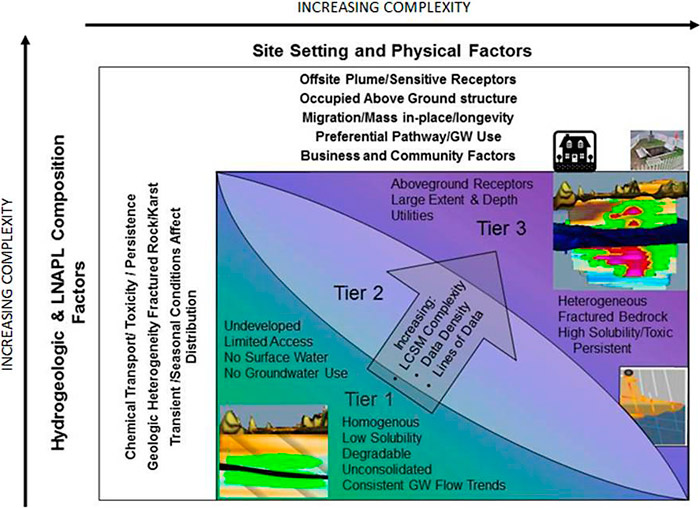
Figure 4-2. Factors governing 1) the potential to achieve a significant reduction in risk and 2) the cost of LNAPL depletion (arrows point in the direction of increase of the noted property). (adapted after (ASTM 2014a)).
It is important to note that a single factor may not increase the level of complexity by itself. Rather, if that factor results in challenges to remediation or confidence in the remedial decision, then the tier is increased. For example, a source zone in heterogeneous soil can either be a tier 3 or a tier 1. Where the source is shallow, the release history is known, and excavation can be performed, a tier 1 LCSM may be appropriate. In the event that excavation is not feasible or desirable due to cost, then additional information may be needed to characterize the distribution of impacts for alternate remedy evaluations. The additional data would identify cost and performance of alternate remedies for more informed decision making.
LNAPL sites are typically evaluated using various elements, including:
- historical data (e.g., LNAPL and dissolved phase footprint evolution, LNAPL occurrence versus potentiometric surface elevation, facility release record, and/or operational record);
- field data such as product recovery rates from interim measures, transmissivity values from baildown testing, and/or tracer dilution tests;
- site-specific laboratory data (e.g., TPH profiling and LNAPL saturations in soil cores);
- analytical and/or numerical modeling results;
- LNAPL risk assessment issues (including the consideration of both current and potential future site conditions);
- high resolution characterization data (e.g., DC resistivity, conductivity, LIF, and MIP); and
- combinations of the above.
The extent to which one particular line of evidence may be needed for the LCSM depends on other available lines of evidence. For example, at a site where there are little or no historical data or where the data sets are extremely sparse, there will be a stronger need for extensive sampling to obtain site-specific laboratory data, possibly supplemented with modeling that incorporates the new data to characterize LNAPL mobility and body stability issues. Conversely, at a site with an abundance of historical data covering the range of water table fluctuations, there will likely be less need to engage in a comprehensive laboratory program or modeling to develop the LCSM. Utilizing this thinking with the tiered concept in Figure 4-2 will support the overall litmus test for an LCSM – is there agreement by all stakeholders that sufficient information is available to make decisions to advance the site forward?
4.2 Initial LCSM
The Initial LCSM is utilized to support identification of concerns, verifying those with the threshold metrics (Section 5.1.1 and Table 5-1) and ultimately defining remedial goals (Section 5.2). Often data collected in the Initial LCSM will support additional portions of the LCSM and may be collected for efficiency of field mobilizations. However, it is not always plausible to understand the concerns, the remedial path forward, and the requirements for remedial design until an initial LCSM is created. A logical step is to collect sufficient information to understand the concerns and then verify them with threshold metrics. As discussed in Section 5.1, the primary categories of concerns include Risk and Safety, Migration, LNAPL Occurrence, and Other Concerns.
The questions described in this section were designed to guide an investigator through the key components of developing the concerns portion of the Initial LCSM. This represents the first steps shown in Figure 4-1.
While there are many questions that can be answered for a site, not all are necessarily relevant or required depending on the level of detail required for the LCSM. The questions in this section are widely applicable to LNAPL sites as they generally have to be answered to develop the LCSM for understanding concerns, risks, and LNAPL source distribution—from the most general (green) to more LNAPL specific concepts (brown).
4.3 LNAPL Tools
Table 4.2 provides additional tools available to characterize a given component of the LCSM. Within the table, each tool typically includes a reference for the method and a brief description. The notes provide insights regarding recently improved best practices for tool selection at sites. It is the intent of this guide to identify available tools and provide an improved understanding of their use where existing standards or literature is not available or an update is needed.
Table 4-2. LNAPL tools for characterizing LCSM components.
View Table 4-2 in Adobe PDF format.
4.4 Remedy Selection LCSM
The Remedy Selection LCSM is utilized to support selection of a remedial technology(ies) and/or controls by characterizing aspects of the LNAPL and site subsurface relative to the potentially employed remedial mechanisms. Update the Initial LCSM (e.g., by pilot testing or detailed/spot assessment) to confirm the site is adequately characterized to screen technologies to address concerns.
The questions described in this section were designed to guide an investigator through the key components of developing the technology evaluation portion of the LCSM. This represents the middle steps shown in Figure 4-1 which seek to review the Initial LCSM and remediation objectives and select the most appropriate means for LNAPL remediation or control. While there are many questions that can be answered for a site, not all are necessarily relevant or required depending on the level of detail required for the LCSM. The questions in this section are widely applicable to LNAPL sites as they generally have to be answered to develop the LCSM for understanding concerns, risks, and LNAPL source distribution—from the most general (green) to more LNAPL specific concepts (brown). Note that the discussion of the questions below are applicable to unconsolidated, bedrock and karst; however, further detail on LNAPL occurrence in fractured rock is provided in the Fractured Rock Appendix.
| |
| |
| |
| |
| |
| |
| |
| |
| |
| |
| |

